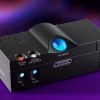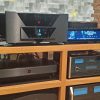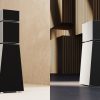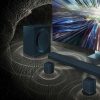Graduation.
In my day job here in Alberta I’m a career and job search coach, and through the summer, graduation has been a big theme for current and former clients. June for university and high school students. July and August for law students completing articles and being called to the Bar. August for CPA Candidates learning whether they passed or failed their final accounting exams in May. Cause for celebrations.
This past summer I’ve also had a graduation of sorts. I finally got to experience the joys of a Moving Coil (MC) turntable cartridge. Cause for celebration? Read on and find out.

Having only gotten back into vinyl in September of 2018, I’m now on turntables number three (Dual 701), four (Denon DP-1200) and five (Technics SL-DL1). All my cartridges have been Moving Magnet (MM), which is what you’ll typically find on entry-level turntables. Can’t say I’ve had any complaints but will say I’ve been curious about what an MC cart would bring to the party.
MC vs. MM
Now if you’re new to vinyl yourself or have been rocking an MM cart for years and never thought about trying something different, here’s a little background.
At a non-technical level, all cartridges have a common structure, with a stylus (the sharp contact point with the record, often a specially cut diamond or similar stone), a cantilever (the rod you see sticking out of the cartridge body that transports vibrations from the stylus in the record groove to the sound generator inside the cartridge), suspension (which acts as a pivot and controls how much the cantilever moves), and the transducer, aka. sound generator (which relies on an interaction between magnets and electric coils to produce the electrical music signal that goes through the wires to your stereo system).
MM and MC cartridges differ on which part of the sound generator moves.

Moving Magnet: A magnet attached to the non-stylus end of the cantilever inside the cartridge moves between fixed electrical coils. The coils read changes in the flux field emitted by the magnet and turn that into a sound signal.
The advantage of an MM cartridge is higher electrical output, at a level that standard phono pre-amps (or phono stages) built into most integrated amplifiers and receivers can convert easily. This is one of the reasons MM cartridges are so ubiquitous; others are that MM styli are user-replaceable, and MM carts are (generally) cheaper than MC.
The disadvantage of MM carts is that the magnet on the cantilever is comparatively heavy and thus slows the reaction time of the stylus, muddying the resulting sound, especially at higher frequencies.
Moving Coil: As the name would suggest, here the coil parts of the sound generator are attached to the cantilever and the magnets are fixed within the cartridge body.
Because the coils are light, the stylus of an MC cartridge is more responsive than an MM cart resulting in better high-frequency transients and greater detail retrieval, hence the attraction to serious audiophiles.

The main disadvantage of MC cartridges is that electrical sound signal output is lower than MM. For low output MC cartridges, the signal is weak enough that the built-in phono stage in most entry-level amplifiers and receivers can’t boost the signal enough to produce listenable music; with these cartridges a separate pre-amp or step-up-transformer (SUT) is required to adequately boost the sound signal without adding noise.
Other disadvantages are non-user-replaceable stylus (stylus re-tipping needs to be done by a specialist), and a higher cost (both of cartridge and supporting equipment) than MM cartridges.
The Sumiko Blue Point No. 3
I’ve mixed and matched a variety of MM carts, and always been curious about a higher-end MC, so was quite excited when approached to try out and review the Sumiko Blue Point No. 3 cartridges. Yes, that’s with an “s” as there are two – a high output and low output version.

Sumiko has been around for almost 40 years. From humble beginnings as a phono cartridge importer, Sumiko now distributes Pro-Ject, Sonus faber, Rotel, Sumiko Phono Cartridges and Bassocontinuo audio racks, and is a proud member of the McIntosh Group.
The new Blue Point No. 3 cartridges were announced in June 2021, replacing the venerable (to those in the know) Blue Point No. 2, for an affordable ($499.00 each) MC design that produces great detail and stereo separation. They benefit from a new shell design, with a smoothly bevelled front fascia allowing excellent visibility of the stylus tip when mounting.

The Blue Point No.3 High Output is compatible with any MM phono stage, while the Blue Point No.3 Low Output is Sumiko’s most accessible low output MC cartridge and pairs well with most high-performance, affordable phono stages.
If you’ve been reading along from the beginning, you now actually understand that last paragraph.
My experience with the Blue Point No. 3
Two of my turntables are set up in my basement listening room: the Dual and the Denon. The Dual is fitted with the sublime Shure V15iii MM cartridge. I sometimes ride other carts, but always return to the V15iii; to me it puts out a perfect blend of warmth, detail and thump.

I was advised that the Sumiko is quite wide and probably wouldn’t fit the standard Dual cartridge sled, so I set up the Blue Point No.3 High Output cartridge on the Denon.
As an aside, I’ve since discovered that the Blue Point No.3s WILL fit the Dual TK-14 shuttle (not sure about the other shuttles for other Duals), so I could try one of them on the 701 if I were willing to go through the hassle of alignment and tracking adjustment. Good thing here though is that Dual users are not necessarily shut out of the Blue Point No.3 game.
I tend to rotate amps quite a bit, and at various points in the last couple of months I’ve been playing music from both turntables through the Sansui AU-999, Sansui-plus-Dynaco ST-70 tube rig, NAD 3020, and Technics SA-500 receiver.

And I noticed something interesting.
I started using the Denon more. And more. And continue to do so.
What I wrote earlier about the speed and detail of MC cartridges is there in spades with the Sumiko. Having never experienced another MC cart for comparison I can’t contrast with other models or manufacturers, but the Blue Point No. 3 sounds spectacular.

Micro details are delivered with beautiful realism: the reed rasp of Johnny Griffin’s saxophone on the Blue Note 80 reissue of Introducing Johnny Griffin, the texture of bow on string on the 2004 Speakers Corner version of Janos Starker’s Bach Cello Suites, the sparkle of piano on the recent Tone Poet release of Sonny Clark’s My Conception. Moments while listening to those records and others where the hair on my arms literally stood on end.
Goosebumps.
The Shure sure is sweet and lush and inviting, and that’s what I love about it. One might worry that the enhanced detail from the Sumiko would result in music delivery that is stark and cold, but that is not the case at all. Perhaps substitute “detail” with “realism” and the description becomes more accurate.
Those same micro details and realism I highlighted already. More goosebump moments. The breathy quality of Norah Jones’ vocals on Come Away With Me. The twang and snap of Mark Knopfler’s guitar on “You and Your Friend” (from On Every Street). The room atmospherics of the Church of the Holy Trinity in Toronto on Cowboy Junkies’ The Trinity Sessions. Crowd noise on Ryo Fukui’s Live at Vidro ’77.

Instrumental separation and soundstage are also excellent. Instruments and voices are clearly differentiated, and placement of each performer in relation to the listener easily discernable.
Output levels are certainly substantial enough that a standard phono stage will have no trouble handling the signal and producing beautiful sounds. Output was a little lower than from most of my MM cartridges, but not significantly. What I would have played at 3/10 on the volume pot with one of my MMs I played at 4/10 with the Blue Point. 4/10 became 5/10. Not a significant difference, and no perceptible impact on noise floor.
If you’re looking for precision and detail without sacrificing engagement and atmosphere, the Sumiko Blue Point No. 3 High Output is a winner.

And what about the Low Output member of the Blue Point pair? Unfortunately, COVID affects not just people and lifestyles, but also logistics. When I heard I’d be getting the Blue Point No. 3 cartridges, I immediately put in an order at one of my local audio stores for a standalone MC phono stage as none of my amplifiers had one built in. I waited, and waited, and am still waiting. The expected delivery never came, so I’m feeling a bit let down as I wrap up this review.

I experienced great pleasure listening to the Blue Point No. 3 High Output. In my limited experience, it’s the best cartridge I’ve heard. Someday I hope to hear the Low Output and see if that really does take things to another level.
Pluses:
- Detail and texture are superb.
- Dynamic and engaging, with great separation and soundstage.
- Output levels (High Output) are suitable for standard phono stages.
- Blue is my favourite color.
Minuses:
- The pandemic and logistics issues meant I didn’t get to try the Low Output model.
For more information: Sumiko Blue Point No. 3
Where to buy: $499 at Crutchfield (High Output) | $499 at Crutchfield (Low Output)



































Mike Cornell
September 14, 2022 at 12:13 pm
Great review, Eric! I’m running a V15iv on my Ariston RD40 and have always been curious about moving coils. I just might give the Sumiko a try!
Ian White
September 14, 2022 at 1:11 pm
I second Eric’s very fine review. Sumiko is making some great cartridges now. The BP No.3 and Wellfleet are very impressive.
Ian White
Eric Pye
December 3, 2022 at 12:30 am
Thanks Mike. The BP3 and V15 (in my case iii) are very different, and both wonderful in their own ways. Hope you do try the Blue Point. Let us know your thoughts when you do.
Dennis
September 15, 2022 at 4:47 pm
I use the BP No. 3 on my Cambridge Alva TT. It is an excellent cartridge. I have Ortofon 2M Blue on my other tables, which is also an excellent cartridge for the money and, in comparison to the BP, is much more bright/loud.
Erik
November 4, 2022 at 6:33 pm
12 months ago, I replaced a wonderful, but worn-out, Grado Platinum wood-bodied cartridge. For years, I had always wanted to try a Blue Point. When the new No. 3 was released, I decided to give the .5mV version a chance, even though I was concerned that the magical Grado ease and realism would disappear and be greatly missed. Well, the only thing that disappeared was my apprehension: The $500 which I shelled out for the Sumiko is probably the best $500 I’ve ever spent. The realism remained, but greater detail, bass articulation, and instrument separation were gained.
Prior to purchasing the Sumiko, I demo’d a Hana EL. I promptly returned it. The BP3 (which is manufactured in the same facility as the Hana) is a much better cartridge.
To sum it all up, ya can’t go wrong with the Blue Point 3.
Ian White
November 5, 2022 at 3:22 pm
Erik,
I totally agree. I’m definitely adding one to my system this year.
Best,
Ian White
Eric Pye
December 3, 2022 at 12:32 am
Sounds like you like the BP3 as much as I do. Isn’t it wonderful when you find something that takes the listening experience to a new level!?
David
June 30, 2023 at 12:32 pm
I have a Denon DP-1200 and love it. I have a Grado Prestige Green3 cart on some cheap universal headshell from Amazon. I’m looking at upgrading to the Sumiko Blue Point No3. It looks like you have the same, or similar, turntable. I’m using a Denon home theater receiver as my amp for now, but plan on getting a tube amp at some point. What headshell are you using? I can’t make out a name on it. Does the headshell weight make a difference to that cart? I’m returning to vinyl after 20 years and a lot has changed.
Ian White
June 30, 2023 at 12:58 pm
David,
It’s probably a Denon or Ortofon-branded headshell. The headshell and cartridge weight do make a difference in regard to the arm and how it will be set-up.
The Sumiko is definitely a cartridge that needs a better quality phono preamp if you want to maximize its performance.
Best,
Ian White
David
June 30, 2023 at 8:22 pm
Thank you! I’m definitely getting a preamp. Just curious if an Audio-Technica AT-HS6BK headshell, that I already have, would be ok. Not sure if there is a specific weight for the headshell that I should look for.
Al
August 4, 2024 at 12:47 pm
I had a Sumiko Blue Point ( original) on a Dual, but found a medium mass tonearm, as on the AR ES-1 to be a better match, as the BP tracks at 2 grams.
T
February 14, 2025 at 9:46 am
Loved the review, would be nice to have the low and high versions compared as well, if you get the time